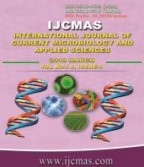Recent Advances in Breeding of Tomato- A Review
Payal Sharma, Seema Thakur* and Radhika Negi
Krishi Vigyan Kendra, Solan at Kandaghat, Dr. YS Parmar University of Horticulture and Forestry, Nauni, Solan, Himachal Pradesh, India
*Corresponding author
Abstract:
Tomato (Solanum lycopersicum L.) is one of the most important vegetable crops under solanaceous group which can be grown both under open field conditions and greenhouses. Tomato has achieved high popularity especially in the recent years because of lycopene’s anti-oxidative activities and anti-cancerous functions. The cultivated tomato has been used in genetic studies because of the ease with which it can be easily manipulated and also its diversity present within the population. The most important breeding techniques used in order to improve tomato has been the method of hybridization followed by pedigree selection. Among all the methods, the back cross method of breeding has been used to transfer the desirable traits from the wild species to cultivated varieties. Breeding methods like pedigree methods, single descent method in combination with the molecular approaches have been found to be useful. Tomato has presented as an example for gene transfer from uncultivated into cultivated cultivars for development of improved varieties of the qualitative traits. Till now the achievements are through different traditional breeding methods. It is the need of the hour to use the traditional method in combination with the recent approaches which takes less time to develop a variety. The population of the country is increasing day by day and to meet the requirement of the whole country, breeder need to develop the high yielding varieties by the use of the combined application of traditional breeding and plant biotechnology methods. Marker-Assisted Selection might prove to be a valuable tool for tomato breeding.
Keywords: Tomato, Wild type, Self pollination, Floral biology, Flavour
Download this article as 
How to cite this article:
Payal Sharma, Seema Thakur and Radhika Negi. 2019. Recent Advances in Breeding of Tomato- A Review.
Int.J.Curr.Microbiol.App.Sci. 8(3): 1275-1283. doi:
https://doi.org/10.20546/ijcmas.2019.803.151
 Citations
Citations



 National Academy of Agricultural Sciences (NAAS)
National Academy of Agricultural Sciences (NAAS)





